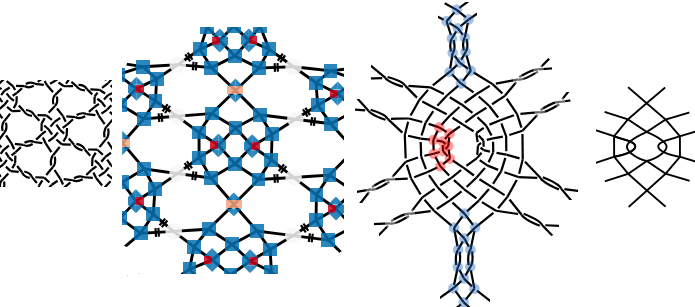
Why another color code?
Various dialects of color codes for pair diagrams are used by bobbin lace designers: There is at least a Belgian version, a simplified Danish version and a red-blue version and perhaps more. These dialects use just one color per stitch what accommodates at most about half a dozen of stitches.
These systems have in common that only one color represents a stitch. These are easy to draw by hand and sufficient for traditional styles of bobbin lace. When experimenting with unorthodox stitches and grounds we need to distinguish more than those half a dozen of colors.
4 colors per stitch
This page explains how GroundForge uses up to four colors per stitch to distinguish up to four crosses per stitch and up to three twists between those crosses, as well as tallies and plain plaits. If we count mirrored versions of stitches, the color code can distinguish over 4K separate stitches. It does have one drawback: the approach may be too elaborate to draw accurately by hand.
Twists
| none | one | two | more | |
|---|---|---|---|---|
| twists between stitches | ||||
| twists between crosses |
Colors for the twists fill blank shapes in the following table.
Crosses
| 1. just a single cross | |
| 2. cross - twist(s) - cross | |
| 3. cross - twist(s) - cross - twist(s) - cross | |
| 4. cross - twist(s) - cross - twist(s) - cross - twist(s) - cross; e.g. brussels stitch: ctct-pin-ctct or winkie pins |
|
ctctctc and longer plaits |
|
cllcrrcllc and longer or mirrored tallies |
|
 |
none of the above |
N.B: Brussels stitches and winkie pins are single stitches for GroundForge: they are manipulations with only two pairs. This phenomenon is also shown below.
Examples of stitches
The following examples combine the color rules relating to twists with the shapes representing the crosses.
Note that each t of the captions is translated into an l plus r in the drawings.
Examples of patterns
To illustrate unorthodox stitches, we compare the system developed for GroundForge with B3.24 from Viele Gute Gründe.
An  in a GrounForge pair diagram may be an
in a GrounForge pair diagram may be an  in a traditional pair diagram.
This is illustrated with highlighted stitches in the thread diagrams.
in a traditional pair diagram.
This is illustrated with highlighted stitches in the thread diagrams.
Below a variation of F9 from the sampler by Gertrude Whiting. It shows the difference between the tick marks for double and triple twists. The pattern shows also variations of winkie pins. One is highlighted red: a cloth stitch, twists around a pin (not mastered by GroundForge) and a cloth stitch that starts the returning row. See also the last one in the examples of stitches above.


The following example follows the transformation from a thread diagram used as pair diagram to thread diagram, a Droste effect. The last diagram is a traditional pair diagram for the eyed spider. In the step from thread to pair diagram the double twists are reduced to a single stitch because everything done with just two pairs is a single stitch in GroundForge. The same would apply to a doubled cross. The second thread diagram highlights a Brussels stitch with a blue color. It creates a cloth stitch at the end of ona spider and another cloth stitch at the beginning of the next spider and two twisted legs in between. The other legs are crossed in the GroundForge pair diagram but by applying just twists to that stitch we get parallel twisted legs. The red highlights represent a single stitch in the GroundForge pair diagram while it represents two stitches in the traditional pair diagram for an eyed spider.

Notes
Color scheme
The color scheme was selected from colorbrewer because of its color-blind friendly properties.
Open and closed methods
Not having twists between stitches encoded in the colors of the stitches, makes the diagrams agnostic to the open (start with twist) and closed (end with twist) method. The tooltip (when hovering over a stitch) are not agnostic: they may have the twist one either one of the stitches.

